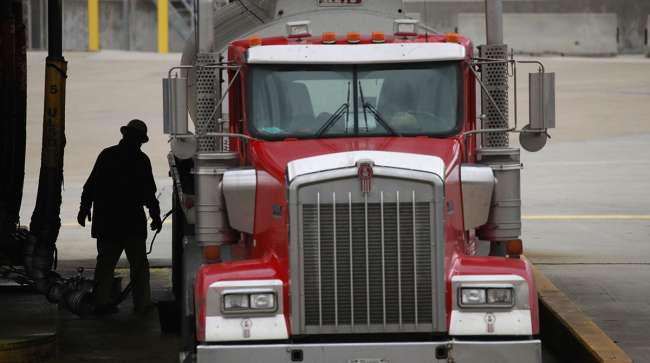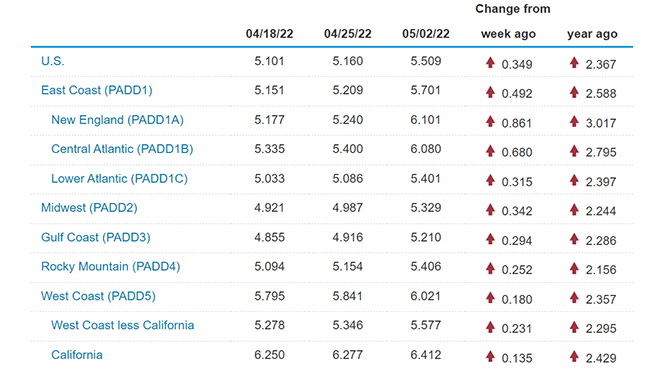Senior Reporter
Diesel Surges 34.9¢ to All-Time Record $5.509 a Gallon

[Stay on top of transportation news: Get TTNews in your inbox.]
The national average price of diesel skyrocketed 34.9 cents to set an all-time record of $5.509 a gallon, according to Energy Information Administration data released May 2.
Trucking’s main fuel blew past the previous record of $5.25 due to the second-largest increase of the year. Diesel surged 74.5 cents March 7.
A gallon of diesel now costs nearly $2.37 more than it did at this time in 2021.
Diesel’s cost rose in all 10 regions in EIA’s weekly survey, ranging from a high of 86.1 cents a gallon in New England to a low of 13.5 cents in California.
U.S. On-Highway Diesel Fuel Prices

EIA.gov
A gallon now costs at least $6 in New England, the Central Atlantic, the West Coast and California. In the other six regions, the price exceeds $5 a gallon, ranging from a low of $5.21 a gallon in the Gulf Coast, where much of the nation’s oil production and refining capacity is located, to $5.70 along the East Coast.
U.S. average on-highway #diesel fuel price on May 2, 2022 was $5.509/gal, UP 34.9¢/gallon from 4/25/22, UP $2.367/gallon from year ago https://t.co/YTM2f88QwX #truckers #shippers #fuelprices pic.twitter.com/np6YPbi3xM — EIA (@EIAgov) May 3, 2022
In nine of the 10 regions, the price of diesel has increased by more than $2 a gallon compared with 2021, and in New England the price is up nearly $3.02 a gallon.
Gasoline increased as well, but not nearly as sharply. An increase of 7.5 cents lifted the national average to $4.182 per gallon. That’s up $1.29 from a year earlier.
The price of West Texas Intermediate crude oil, the industry’s main benchmark fuel, has been trading between $107.61 a barrel April 18 and $98.54 a barrel April 25, and most of April sitting near $103. On May 3, WTI was at $103.39, up 97 cents on the June futures contract.

Flynn
Oil industry analyst Phil Flynn told Transport Topics that the price of oil-related products is likely to remain volatile for the foreseeable future.
“I think the price depends on the time of day; we’ve gone everywhere today. We’ve been above $105 today, then $103, and if you don’t like the price of oil, give me 10 minutes and call me back,” he said May 3. “The market is in a flux right now. They are waiting on the answers to a lot of questions. There is just a lot we don’t know.”
Flynn says as prices for oil, diesel and gasoline are substantially higher than they were a year ago, it appears supplies are tightening and that could cause availability and costs to rise.
On May 3, the American Petroleum Institute in its weekly update on oil inventories reported a larger-than-anticipated drawdown for crude oil of nearly 3.48 million barrels. Analyst predictions called for 1.16 million barrels.
American energy leadership is critical for global energy security, and without the growth in US production over the past decade the US and our allies likely couldn’t take such strong and necessary steps against Russia. pic.twitter.com/zWbwREsWmm — American Petroleum Institute (@APIenergy) May 2, 2022
“Inventories are coming in below average,” Flynn said. “This is a very bullish API report. We just got a sucker punch from these numbers and they will drive the market higher. Supplies of fuels in the U.S. are well below normal for this time of year, and the higher prices we’ve been seeing are justified.”
API said that since the beginning of 2021, U.S. crude inventories have declined by an estimated 73.5 million barrels, and dating to 2020, another 17.5 million barrels.

ATA's Glen Kedzie and Transport Topics' Eric Miller dive into the realities and challenges of the proposed new NOx standard, what it means for truck manufacturers and for the industry's electric future. Tune in above or by going to RoadSigns.TTNews.com.
The decline in oil inventories comes when President Joe Biden in late March ordered the release of 1 million barrels of oil per day from the U.S. Strategic Petroleum Reserves for six months. Biden cited rising prices and tight supplies, brought on in part from Russia’s invasion of Ukraine and the economic sanctions being imposed on Russia’s economy, much of which is propped up by oil exports.
Even with the summer driving season approaching and freight volumes remaining strong, U.S. oil production is struggling to reach its pre-COVID-19 levels.
For the week ending April 22, EIA said production is up to 11.8 million barrels per day. But that’s an increase of only 2% since December, and that figure remains well below the record 13.1 million barrels a day, which was set in March 2020 — just before the pandemic began to wreak havoc. EIA forecasts that for the full year, American oil production will increase to 12 million barrels per day and to 13 million barrels in 2023. But that increase still will fall short of the nearly 4 million barrels of oil that European nations imported every day from Russia.

The weekly Baker-Hughes rig count shows another incremental, week-over-week increase in operating rigs in the U.S.
Three more rigs began operating the week ending April 29, bringing the total to 698. That’s up 258 from the same week a year ago.
Baker-Hughes has been charting the number of operating rigs in the U.S. as a service to the petroleum industry since 1944.
Want more news? Listen to today's daily briefing below or go here for more info:




